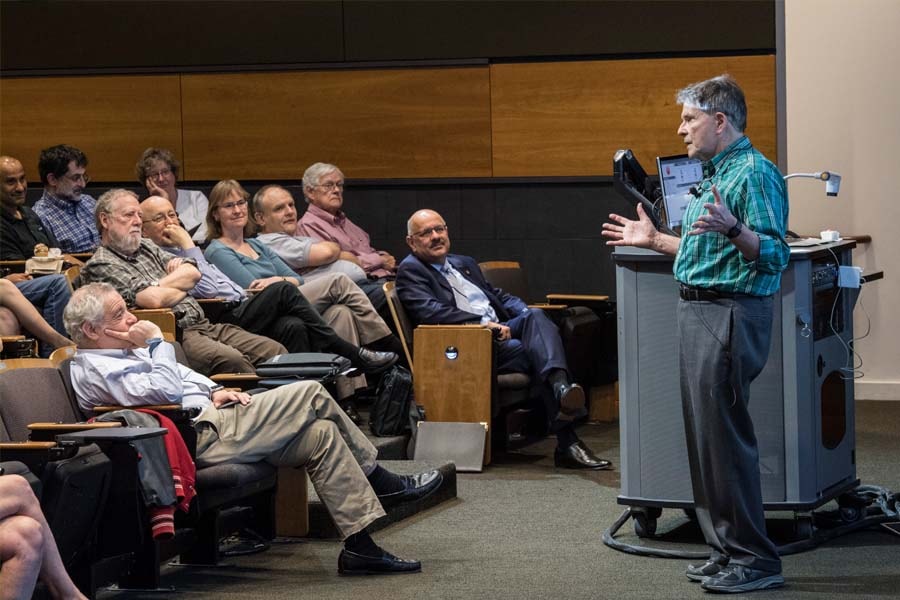
Former SCS Dean Shares Personal History With Computing Pioneers
By Heidi Opdyke
Professor Emeritus James Morris, former dean of the School of Computer Science at Carnegie Mellon University, is a legend in his field. But in rich and lively lecture looking back on his career, it was the other giants he encountered along the way that Morris wanted to talk about — stories of Alan Perlis, Herb Simon, Robert Taylor, Allen Newell, Raj Reddy and others.
The standing-room-only crowd reveled in Morris’ journey through the early days of computer science, and also gave Morris his rightful place among those founders. CMU President Farnam Jahanian, who introduced Morris, described how Morris influenced the field through research and mentoring generations of computer scientists.
"It's easy to lose count of all the ways that Jim Morris has enhanced our lives, both as consumers of information technology and as members of the CMU community who care so deeply about using technology to improve the human condition," Jahanian said.
A Pittsburgh native, Morris wanted to go to MIT or Caltech but considered then-Carnegie Tech.
"Carnegie Tech offered me a full scholarship," Morris said. "As my mother's only child — my father had died a few years before that — going to Tech seemed like a good thing to do. In fact, it turned out to be a great thing to do for my career."
The First Computer Scientist
As an undergraduate, Morris played football and served as president of Delta Upsilon fraternity. But he also studied computer programming under Alan Perlis after a friend told him about the "crazy teacher."
"Perlis used to give whimsical homework problems: one day it was to design a language that described hotel room parameters," Morris said. "Probably because he had been in a hotel that day."
Morris described Perlis as an administrator who saw the importance of student computing and who removed obstacles so innovations could happen rapidly at CMU.
20th Century Galileo
Herb Simon, who Morris called a "20th Century Galileo," loomed large in Morris' undergraduate career. He recalled one Simon lecture on how to be creative.
"Herb's idea was a fundamental belief that genius wasn't magic. It wasn't based on some intangible product of your brain, it had to do with practice," Morris said. "He said if you want to be world-class on something you had to spend 10 years at it."
After Carnegie Mellon, Morris earned his master's and doctor's degrees in management and computer science, respectively, from MIT. And in 1969, he became an assistant professor of computer science at the University of California at Berkeley. There, he contributed to important underlying principles of programming languages. He also was a co-discoverer of the Knuth-Morris-Pratt string search algorithm, a fast method for locating a phrase inside a large body of text.
Demanding Coach
In 1974, Morris joined the Xerox Corporation research staff at its Palo Alto, Calif., research center, where he was eventually promoted to principal scientist and research fellow. During that time, he helped to develop the Alto System, the first distributed personal computer system.
At Xerox, he met Robert Taylor, a manager who oversaw many of the company's brilliant computer scientists. Morris said Taylor's leadership style transfixed him.
"All of our egos were wrapped up in how smart we were," Morris said. "Bob's ego was aimed at something else. He was like a football coach who accumulated the best talent available and nurtured that talent and deployed it. For Bob, winning meant often challenging IBM."
The Lone Ranger
Morris also saw Allen Newell as mentor who reminded him of his childhood hero, the Lone Ranger.
"There would be a problem, and he would come to town, do something brilliant, then ride out of town back to his research," Morris said. "Newell had a huge amount of courage, jumping into any topic and trying to understand it. That was really special."
Morris returned to Carnegie Mellon in 1982 as a visiting fellow from Xerox and founding director of the Information Technology Center (ITC), a joint venture with IBM. As ITC head from 1983 to 1988, he helped to conceive and engineer Andrew, one of the world's first university-wide computing and communications networks.
Newell, who was among the people who encouraged Morris to return to CMU, told Morris that the most important part of the Andrew project was to get the network right.
"That turned out to be completely true," Morris said. "Part of the system is still running 30 years later, which is amazing."
Modern Circumnavigator
Raj Reddy, the Moza Bint Nasser University Professor of Computer Science and Robotics and a former SCS dean, attended Morris' talk.
"I think of Newell, Simon and Perlis as my father figures, and I think of Raj Reddy as my big brother," said Morris, who said you never knew where Reddy was because of his frequent globetrotting. "He has the chutzpah of Perlis with the grace of Newell."
From 1992 to 2004 Morris served as department head and then dean in the School of Computer Science. He held the Herbert A. Simon Professorship of Human Computer Interaction from 1997 to 2000. He was the dean of CMU's Silicon Valley campus from 2004 to 2009, which he also helped create. He also is a founder or helped to establish CMU's Human-Computer Interaction Institute and Information Networking Institute, the consulting firm MAYA Design, the Robot Hall of Fame and iCarnegie.
After sharing nicknames for his mentors, who also include his wife, CMU alumna Susan, who he called a "conversationalist," Morris called himself a "serial administrator."
"I was trying to emulate these great leaders of the past, to do what I can to help the institution, but it's really to honor them that I was doing these jobs," Morris said. "They were impossible acts to follow. I couldn't possibly match that, but I was attempting to help."